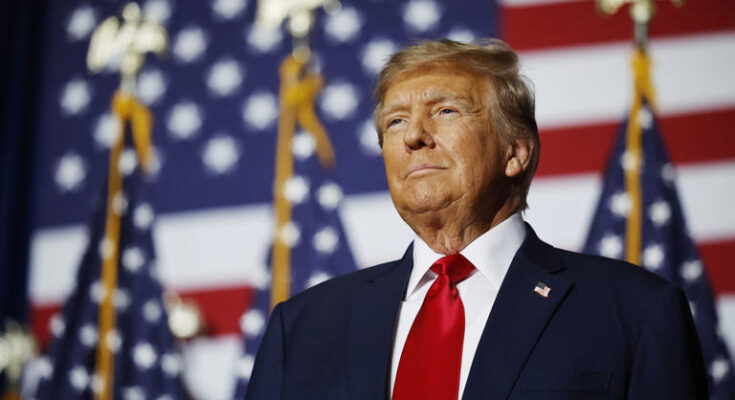Donald J. Trump, the once and now future president, capped an improbable political comeback by defeating Vice President Kamala Harris on promises to turbocharge the economy and deport undocumented immigrants by the millions.
NBC News projected the Trump victory over Harris, who was the first woman of color to win a major party nomination for president, early Wednesday morning. She took the reins of the Democratic campaign after President Joe Biden abandoned his bid for a second term, a decision made in the wake of a disastrous June debate performance.
The most polarizing figure in modern American politics, Trump now must preside over a nation deeply riven by social, racial, cultural and economic hostilities that he has strategically exploited on the campaign trail for nearly a decade. It was, for him, a successful strategy. The last time a defeated U.S. president avenged his loss was Grover Cleveland — in 1892.
“This was the greatest political movement of all time,” Trump said just before 2:30 a.m. Wednesday at a rally in West Palm Beach, Florida. “Now it’s going to reach a new level of importance because we’re going to help our country heal.”
Trump’s path back to the White House ran through Pennsylvania, Georgia and Wisconsin, states he reclaimed after losing them in 2020. He remained locked in close contests with Harris in Michigan, Arizona and Nevada as he looked to pad his Electoral College margin.
It was a campaign unlike any other, waged by a unique figure in American history. Trump emerged victorious despite facing a dozen Republican primary challengers, four indictments, a criminal conviction, a finding that he was liable for sexual abuse, the bullet of a would-be assassin and the Democratic candidacies of the president and his vice president.
Nothing served as a more apt metaphor for Trump’s perseverance than his reaction to being shot at a rally in Butler, Pennsylvania, in July. After a bullet clipped his right ear, a bloodied Trump rose to his feet, jabbed his fist in the air and yelled “Fight, Fight, Fight!” The iconic sequence was incorporated into late-campaign ads as part of his closing argument.
Trump’s return to the White House extends a volatile era in which both the presidency and control of Congress have routinely been decided by the thin margins, reflecting an electorate almost evenly split between the two major parties. Through a firehose of false and polarizing information and smears of his rivals, especially Harris, Trump painted America as a corrupt, economically failing and crime-ridden nation. He leaned into violent rhetoric, referring to a shooter firing into the reporters covering his rallies or guns being pointed at a former U.S. Republican representative who doesn’t support him.
Voters chose him to lead the path forward, despite warnings from the left and his own former aides that he will rule as an authoritarian.
It wasn’t just Trump who endured. His Make America Great Again movement proved resilient with voters. Trump re-harnessed the backlash against establishment powers during his grievance-filled third campaign, according to former House Speaker Newt Gingrich, who is an informal adviser to the president-elect.
“The great mistake that analysts make is that they focus on Trump, rather than the underlying momentum that has created Trump,” Gingrich said in an interview with NBC News. “Trump is the personification of at least half the country rejecting, decisively and vehemently, the governing elite.”
And yet Trump will have to work with the governing elites in Congress to enact laws and fulfill his mandate. During Trump’s first term, he found resistance to the most extreme elements of his agenda in both parties. Riding his coattails, Republicans in 2024 seized control of the Senate, while control of the House still hung in the balance as of Wednesday morning.
Trump’s campaign this time was fought mostly on familiar policy and political terrain, including promises to cut a suite of taxes — for Social Security recipients, tipped workers and wage earners — raise tariffs and stop illegal immigration. Trump rode the perception that his business acumen would help alleviate prices at the grocery store, in the housing market and beyond.
The outcomes of congressional races that haven’t yet been called could affect his ability to deliver on his policy agenda. But there are signs, including Biden and Harris supporting tougher border security, that he has moved the debate about immigration — even among Democrats — in his direction.
Trump has said on the campaign trail that he would quickly end long-running wars in Ukraine and the Middle East. But he was reticent when it came to the details. His critics fear that his adoration for global strongmen — Russia’s Vladimir Putin, first and foremost — is a harbinger of him pursuing a more authoritarian course at home. For Ukraine, that could mean being forced into a bad deal to end Russia’s yearslong invasion.
Trump’s opponents worry that his wide authoritarian streak will lead him to follow through on threats to prosecute, harass and even deport his political adversaries, including officials who prosecuted him.
“WHEN I WIN, those people that CHEATED will be prosecuted to the fullest extent of the Law, which will include long term prison sentences,” Trump wrote on the Truth Social media platform in September. “Please beware that this legal exposure extends to Lawyers, Political Operatives, Donors, Illegal Voters, & Corrupt Election Officials.”
That vow represented a new chapter in the ongoing saga of his refusal to accept that he was beaten in a free and fair election in 2020 when he lost to Biden. This culminated in his Jan. 6 , 2021, rally at The Ellipse, an outdoor area at the foot of the White House, at which he urged his supporters to march on the Capitol where lawmakers were set to certify his loss.
A pro-Trump mob sacked Congress, injuring scores of police officers and threatening to hang Vice President Mike Pence, who had committed to accepting the results. The multi-front campaign to reverse the outcome of the election led to Trump’s second impeachment by the House and federal criminal charges.
He never conceded the 2020 election, despite no evidence that he had won it. In a way, his supporters never conceded, either.
“I think there were serious problems in 2020,” Vice President-elect JD Vance, a Republican senator from Ohio who was recommended for the ticket by Trump’s sons Don Jr. and Eric, said in October. “So did Donald Trump lose the election? Not by the words that I would use, OK? I really couldn’t care less if you agree or disagree with me on this issue.”
Same candidate, new campaign
Trump didn’t change. He waged a vitriolic campaign that demonized many Americans. He called Harris names — “nasty,” “stupid” and “fascist” among them — and questioned her racial identity. He leaned hard into a gender gap that favored him with men and her with women. Toward the end of the campaign, he pledged to “protect” women “whether the women like it or not.”
But while Trump often veered off track, his tightly run campaign organization stuck to the policy issues where polls showed he had an advantage over Harris. That effort, led by longtime political operative Susie Wiles, focused on replacing Trump’s chaotic past campaign and White House operations with a leaner, lower-drama organization.
The new sense of order, Republican insiders say, helped the famously undisciplined candidate by keeping his campaign team on message and aimed at achieving strategic and tactical goals. There were tensions behind the scenes at times, including when Trump tapped his first 2016 campaign manager, Corey Lewandowski, to audit the operation in the fall. But few of them surfaced into public view or disrupted the candidate, and Wiles became the first top staffer to survive an entire Trump campaign or White House term.
Beyond the economy and immigration, Trump argued that he was better suited to end the wars in Gaza and Ukraine, and he hammered Harris with millions of dollars in ads devoted to her support for gender-affirming surgery. “Harris is for they/them” and “Trump is for you,” a narrator said in the ads, which often aired during sporting events watched more by men than women.
At the ballot box, Trump trounced Harris among men, while she ran up the score with women. On matters where Harris had the edge, including abortion, Trump sometimes distanced himself from his own record.
After boasting about appointing three Supreme Court justices who voted to overturn federal abortion protections, Trump changed his tune following the 2022 midterm elections. Sticking with his argument that states should decide on abortion restrictions, he declared himself a supporter of exceptions in cases of rape, incest and endangerment of the life of the mother.
Same office, new power
The only American president impeached twice, indicted four times and convicted of criminal activity, Trump will return to an office that has since been empowered by the high court.
In a 6-to-3 decision this summer, the justices ruled — in his favor — that presidents cannot be held criminally liable for actions they take in conjunction with their official duties. That gives Trump, free from worry about legal consequences, more power than he had in his first term.
As he again pursues a reimagination of the government’s role in American life — including plans to crush the civil service, slash federal tax revenue and dictate school curricula — his supporters are excited and his foes are scared.
“He is loved by some for the same reasons he is despised by others,” said Republican strategist Matthew Bartlett. “Right now, half the country feels vindicated and liberated, while the other half of the country feels targeted and conquered.”
Same GOP, new election
Trump’s historic return to power — he is only the second president to lose his job and win it back — was kindled in the ashes of the Jan. 6 insurrection. His critics contend, for that and other reasons, that he represents a clear and present threat to American democracy, an argument that Biden and Harris did not prosecute to the satisfaction of enough voters in the key states.
After his first term, Trump returned to his Mar-a-Lago resort in Palm Beach, Florida, and used his platform, his hold on the Republican base and the power of his primary endorsements to begin rebuilding. He wanted to announce his bid for a second term in the summer of 2022 but heeded the counsel of advisers who prevailed on him to wait until after that year’s midterm elections.
By that time, several Republican hopefuls, most notably Florida Gov. Ron DeSantis and former U.S. Ambassador to the United Nations Nikki Haley, were eyeing primary challenges. Some Republicans blamed Trump for picking winners in primaries who went on to lose marquee Senate elections, depriving the GOP of a majority in the upper chamber. In December 2022, several national surveys showed DeSantis leading Trump by wide margins in a hypothetical head-to-head matchup.
But Trump proved resilient, aided by a series of court cases that bound Republican voters closer to him. He received a polling bump after a New York grand jury indicted him on charges of falsifying business records to hide an alleged affair with the adult actress Stormy Daniels. Trump, who denied the affair, was convicted on all of the charges in May. He has not yet been sentenced.
Likewise, Republican voters came to his defense when he was charged in separate federal indictments over his efforts to overturn the 2020 election and his retention of classified documents following his presidency. And they rallied around him when he was charged in Georgia for his attempt to reverse that state’s electoral outcome. And in May 2023, Trump was found liable of sexual assault in a New York civil trial.
His Republican critics did not coalesce around a single alternative, and Trump cruised to victories in each of the early state caucuses and primaries in the winter and spring of 2024. DeSantis dropped out before the Jan. 23 New Hampshire primary, the second contest on the calendar, and Haley followed suit in early March. Trump would ultimately win every state but Vermont — and the District of Columbia — in the GOP primaries.
Same Trump, new rival
Once it became clear that he would win his third consecutive Republican nomination, Trump turned his eyes more squarely to Biden. He believed that the president was no match for him the second time around and dared Biden to debate him.
In a fateful decision, Biden agreed to a June debate, far earlier on the calendar than the traditional timeframe for one-on-one matchups between party nominees. Biden appeared lost at times on the debate stage and unable to counterpunch against the always combative Trump. Biden was met with a deluge of calls — from Democratic lawmakers, operatives and even Hollywood star George Clooney — to step aside, making his candidacy largely untenable.
Biden did that on July 21, immediately endorsing Harris as his successor. Trump hadn’t just knocked Biden down during the debate, he’d knocked the president clean out of the ring. He protested that Democrats pulled a switcheroo — inaccurately casting the change as unconstitutional — but soon settled into running against a foe that he derided as “stupid” and too liberal for the country.
It’s been 132 years since Cleveland avenged his defeat, and Trump’s victory is the first time since that era that the White House has changed party hands in three consecutive elections.
Today, some analysts read that, and public polling, as part of an apparent truth: Voters are dissatisfied with their leaders.
This article was originally published on NBCNews.com




